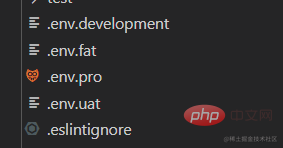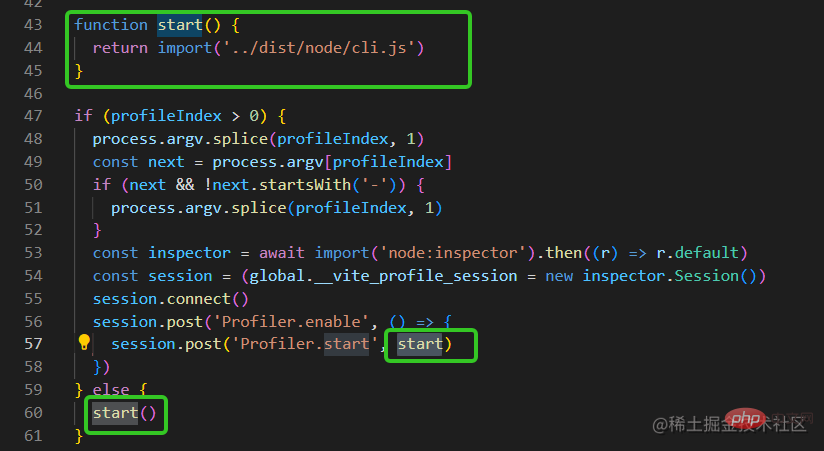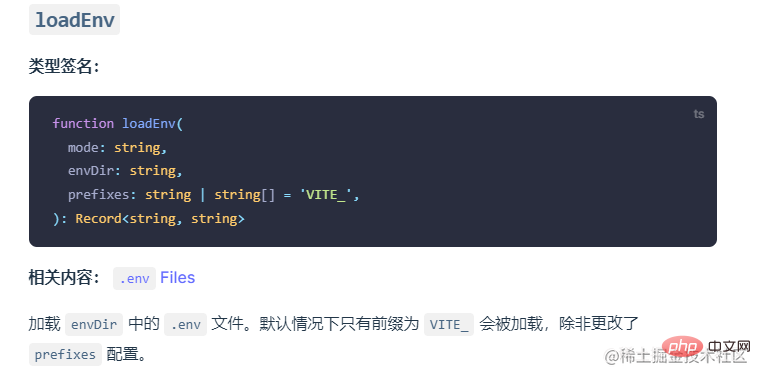
使用vue框架开发前端项目时,我们部署的时候都会部署多套环境,往往开发、测试以及线上环境调用的接口域名都是不一样的。如何能做到区分呢?那就是使用环境变量和模式。
使用vite构建的vue3项目中,可以在根目录下创建.env.[模式]文件定义一种或多种模式,并且在这个文件中定义的变量就是此模式的环境变量。定义了环境变量之后就可以通过import.meta.env.[变量名]的方式读取环境变量了。【相关推荐:vuejs视频教程、web前端开发】
那么我们要来思考两个问题:第一,vite如何读取.env文件中定义的配置;第二,vite如何将.env文件中配置的环境变量挂载到import.meta.env环境变量上的。通过学习今天vite中的相关源代码我们就能够明白。欢迎阅读本文学习,如果有错误的地方请不吝指正。
1.1 问题的着眼点是什么?
首先我们看一下vite如何读取.env文件中定义的配置。如下图所示,在项目根目录下有.env.development,.env.fat,.env.uat,.env.pro四个模式文件,其中development模式是对应默认的开发环境用于本地开发,fat模式对应的也是开发环境用于自测,uat模式对应的是预发布环境用于测试团队测试,pro模式对应的是生产环境也叫线上环境用于客户使用。

那么如何能够让vite知道我们要使用相关模式的文件呢?运行vite 或者vite build命令时可以通过--mode或者-m设置环境模式(详见文档),如下图所示:

这就提示我们要了解vite如何读取定义环境变量的模式文件则需要从vite命令或者vite build命令入手,接下来从vite命令入手研究一下。
1.2 vite的命令定义在何处?
看一下vite的package.json文件(路径:vite/packages/vite/package.json):

当我们使用vite命令的时候,会执行bin目录下的vite.js文件,看一下这个文件(路径:vite/packages/vite/bin/vite.js):

可以看到这段代码的关键是执行start方法,而start方法是导入打包后的cli.js文件,那么这个打包后的文件对应的原文件是哪个文件呢?vite打包的时候是使用rollup的,所以我们看一下rollup的配置文件(路径:vite/packages/vite/rollup.config.ts):

如上代码可以看出vite相关命令的定义在/src/node/cli.ts 这个文件当中。
1.3 vite的命令是如何定义的?
我们来看一下vite的命令是如何定义的(路径:vite/packages/vite/src/node/cli.ts):
import { cac } from 'cac'
const cli = cac('vite')
cli
.option('-m, --mode <mode>', `[string] set env mode`)
cli
.command('[root]', 'start dev server') // default command
.alias('serve') // the command is called 'serve' in Vite's API
.option('--port <port>', `[number] specify port`)
.action(async (root: string, options: ServerOptions & GlobalCLIOptions) => {
const { createServer } = await import('./server')
try {
const server = await createServer({
root,
base: options.base,
mode: options.mode,
configFile: options.config,
logLevel: options.logLevel,
clearScreen: options.clearScreen,
optimizeDeps: { force: options.force },
server: cleanOptions(options),
})
})如上代码所示,vite主要是使用cac这个命令行工具库定义命令的,解释一下这里使用到的cac的相关API:
cac(name?):用于创建一个cac实例,name参数是可选的。
option(name, description, config): 用于设置配置项。
command(name, description, config?): 声明cli命令,可以给命令设置独立的配置项喝其配置后的执行动作。
command.alias(name):给cli命令起别名。
action(callback): 指定命令所执行的操作。
可以看出,当运行vite命令的时候会执行createServer方法,我们这里要注意参数mode就是我们运行命令时通过--mode 或者 -m指定的参数,下面来研究createServer方法。
看一下createServer方法(路径:createServervite/packages/vite/src/node/server/index.ts):
import { resolveConfig } from '../config'
export async function createServer(
inlineConfig: InlineConfig = {},
): Promise<ViteDevServer> {
const config = await resolveConfig(inlineConfig, 'serve')
}可以看到createServer方法调用的是resolveConfig方法,下面看一下resolveConfig方法。
resolveConfig方法的代码如下(路径;vite/packages/vite/src/node/config.ts):
import { loadEnv, resolveEnvPrefix } from './env'
export async function resolveConfig(
inlineConfig: InlineConfig,
command: 'build' | 'serve',
defaultMode = 'development',
defaultNodeEnv = 'development',
): Promise<ResolvedConfig> {
const envDir = config.envDir
? normalizePath(path.resolve(resolvedRoot, config.envDir))
: resolvedRoot
const userEnv =
inlineConfig.envFile !== false &&
loadEnv(mode, envDir, resolveEnvPrefix(config))
const resolvedConfig: ResolvedConfig = {
command,
mode,
env: {
...userEnv,
BASE_URL,
MODE: mode,
DEV: !isProduction,
PROD: isProduction,
},
}
const resolved: ResolvedConfig = {
...config,
...resolvedConfig,
}
return resolved
}可以看到resolveConfig的主要工作:
首先确定.env文件的路径
然后调用loadEnv方法加载解析.env文件,将结果赋值给userEnv
最后返回整个解析后的配置
我们看到这里的关键代码是loadEnv(mode, envDir, resolveEnvPrefix(config))下面我就重点看一下loadEnv方法。
loadEnv方法是vite中一个比较核心的方法,也作为vite对外提供的一个JavaScript API,用于加载 envDir 中的 .env 文件。

我们看一下loadEnv方法(路径:vite/packages/vite/src/node/env.ts):
import { parse } from 'dotenv'
import { arraify, lookupFile } from './utils'
export function loadEnv(
mode: string,
envDir: string,
prefixes: string | string[] = 'VITE_',
): Record<string, string> {
prefixes = arraify(prefixes)
const env: Record<string, string> = {}
const envFiles = [
/** default file */ `.env`,
/** local file */ `.env.local`,
/** mode file */ `.env.${mode}`,
/** mode local file */ `.env.${mode}.local`,
]
const parsed = Object.fromEntries(
envFiles.flatMap((file) => {
const path = lookupFile(envDir, [file], {
pathOnly: true,
rootDir: envDir,
})
if (!path) return []
return Object.entries(parse(fs.readFileSync(path)))
}),
)
// only keys that start with prefix are exposed to client
for (const [key, value] of Object.entries(parsed)) {
if (prefixes.some((prefix) => key.startsWith(prefix))) {
env[key] = value
} else if (
key === 'NODE_ENV' &&
process.env.VITE_USER_NODE_ENV === undefined
) {
// NODE_ENV override in .env file
process.env.VITE_USER_NODE_ENV = value
}
}
return env
}如上代码所示理解loadEnv方法注意以下几个方面:
该方法接收三个参数,分别是模式、.env文件的路径还有环境变量的前缀。
使用递归方法lookupFile找到.env文件的路径,使用fs.readFileSync读取文件。
使用dotenv提供的方法解析.env文件内容。
关于dotenv可以学习川哥的文章,也可以看看笔者的源码共读语雀笔记。至此,我们了解了vite是如何读取.env文件中定义的环境变量了。下面我们研究第二个问题vite如何将.env中配置的环境变量挂载到import.meta.env环境变量上。
2.1 vite的环境变量和import.meta
Vite 在一个特殊的 import.meta.env 对象上暴露环境变量,有一些在所有情况下都可以使用的内建变量:
import.meta.env.MODE: {string} 应用运行的模式。
import.meta.env.BASE_URL: {string} 部署应用时的基本 URL。他由base 配置项决定。
import.meta.env.PROD: {boolean} 应用是否运行在生产环境。
import.meta.env.DEV: {boolean} 应用是否运行在开发环境 (永远与 import.meta.env.PROD相反)。
import.meta.env.SSR: {boolean} 应用是否运行在 server 上。
详见环境变量。这里我们要解释一下import.meta。它是一个给JavaScript模块暴露特定上下文的元数据属性的对象。它包含了这个模块的信息,比如说这个模块的URL。详见import.meta 的MDN文档。需要注意不可以在模块的外部使用import.meta,如下图所示:

2.2 resolveConfig
在上文中我们已经研究了resolveConfig的代码,我们再来看以下此方法中的另一段代码(路径:vite/packages/vite/src/node/config.ts):
import {resolvePlugins,} from './plugins'
export async function resolveConfig(
inlineConfig: InlineConfig,
command: 'build' | 'serve',
defaultMode = 'development',
defaultNodeEnv = 'development',
): Promise<ResolvedConfig> {
(resolved.plugins as Plugin[]) = await resolvePlugins(
resolved,
prePlugins,
normalPlugins,
postPlugins,
)
}这里调用了resolvePlugins,接收resolved对象,此对象中含有开发者所指定的模式以及.env文件中的环境变量。我们接着看一下resolvePlugins方法。
2.3 resolvePlugins
节选resolvePlugins方法如下(路径:vite/packages/vite/src/node/plugins/index.ts):
import { definePlugin } from './define'
export async function resolvePlugins(
config: ResolvedConfig,
prePlugins: Plugin[],
normalPlugins: Plugin[],
postPlugins: Plugin[],
): Promise<Plugin[]> {
return [
//...
definePlugin(config),
//...
].filter(Boolean) as Plugin[]
}resolvePlugins负责解析插件,这里面调用了definePlugin方法,我们看一下。
2.4 definePlugin
definePlugin的代码如下(路径:vite/packages/vite/src/node/plugins/define.ts):
const importMetaKeys: Record<string, string> = {}
const importMetaFallbackKeys: Record<string, string> = {}
if (isBuild) {
const env: Record<string, any> = {
...config.env,
SSR: !!config.build.ssr,
}
for (const key in env) {
importMetaKeys[`import.meta.env.${key}`] = JSON.stringify(env[key])
}
Object.assign(importMetaFallbackKeys, {
'import.meta.env.': `({}).`,
'import.meta.env': JSON.stringify(config.env),
'import.meta.hot': `false`,
})
}这段代码的关键部分在于第8-10行的for循环,将.env文件中定义的环境变量挂在到了import.meta.env上。至此,如何也了解了vite是如何将环境变量挂在到import.meta.env环境变量上。
通过阅读vite的源码,我们了解到vite处理.env文件时涉及到的两个关键问题:第一,vite如何读取.env文件中定义的配置;第二,vite如何将.env文件中配置的环境变量挂载到import.meta.env环境变量上。
对于第一问题,我们了解到vite使用cac定义命令,当执行vite命令并通过--mode或者-m选项指定模式的时候,vite会拿到mode, 然后vite会去项目目录下查找对应.env.[模式]的文件并读取其内容,然后通过dotenv的parse方法解析文件内容,将定义的环境变量整合到resolved中。
对于第二个问题,我们了解到vite的resolveConfig方法中会执行插件解析的方法resolvePlugins,而此方法又会调用definePlugin方法,在definePlugin方法中会完成将.env文件中定义的变量挂载到import.meta.env环境变量上。
以上就是深入探讨vite是怎么解析.env文件的的详细内容,更多请关注php中文网其它相关文章!

每个人都需要一台速度更快、更稳定的 PC。随着时间的推移,垃圾文件、旧注册表数据和不必要的后台进程会占用资源并降低性能。幸运的是,许多工具可以让 Windows 保持平稳运行。




Copyright 2014-2025 //m.sbmmt.com/ All Rights Reserved | php.cn | 湘ICP备2023035733号